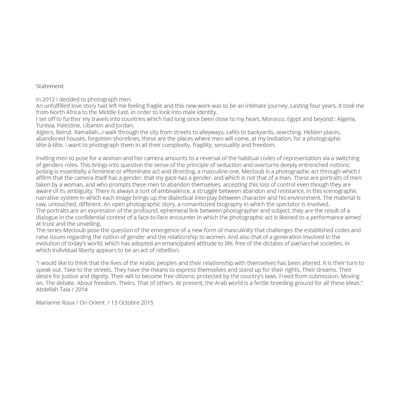












































Plan américain
(Version française ci-dessous)
Plan Américain (2017/2019), is the second chapter of a larger study on new contemporary masculinities, titled: M.
Following up on the work initiated in the Arab world (Mectoub 2012/2016), this new series is devoted to the United States territory.
M brings together three series of photographs taken in the Mediterranean basin, Trump’s America and France, that explore contemporary masculinities and the political act inspired by the younger generations’ determination to be and express who they really are.
These photographs are an exploration from a reverse perspective, through the female gaze, of men (assigned as such at birth) who are sowing trouble in gender and freeing themselves from the constraints and pressures of the traditional model; men who are rethinking the notion of identity and redefining masculinity in new and diverse ways.
The trilogy was begun in 2012 to support and highlight a generation who, for over a decade, have shaken the structure of gender and transformed the world’s vision of it. In this project, I took on the challenge of introducing into the collective imagination these singular yet shared experiences and these men’s assertive reinvention of themselves.
At a time when the desire for authenticity, or self-definition, has become a societal issue and the notion of « toxic masculinity » is subverting stereotypical representations, this body of work seeks to shatter the myths and compel us to rethink notions of gender and identity beyond our usual cultural and geographical boundaries.
Mectoub (2012/2016) was begun during the « Arab Spring » uprisings. I traveled to North Africa and the Middle East (Morocco, Algeria, Tunisia, Palestine, Egypt, Lebanon, and Jordan) to explore, in the context of these protests, the emergence of new masculinities in societies where the expression of individual freedom is an act of transgression.
I began Plan Américain (2017/2019) just after the election of President Trump. His encouragement of hard and retro virility convinced me of the importance of showing the presence of an uninhibited masculinity in an America in crisis where a masculinist nationalism was on the rise.
La Disparition de James Bond (2022/2023) is the third and final chapter of this artistic journey that has taken me to three continents and brought me back to my native country, France. In view of the growing resistance to gender fluidity and social diversity that we are witnessing across Europe, I believed it was important to add this series to give an even stronger voice in support of new masculinities.
For men today, to be vulnerable and speak their truth is an act of rebellion. My work exists to fuel this rebellion.
M is a celebration of openness, adaptability, audacity, an absence of limitations, and a call for empathy, acceptance, and freedom.
* The « Plan Américain », as French directors call it, refers to a specific way of framing movies, developed for Westerns. It allows viewers to see a character from head to mid-thigh and comes from the necessity to include the character’s gun usually located below the belt, in the shot. Particularly praised by French movie makers, it brings us closer to the subject, whilst showing his or her background. A confrontational perspective, it allows for a greater proximity between the viewer and the character.
The word « plan », part of the French expression: « avoir un plan », means: to have a date, a « rendez-vous ».
Plan Américain (2017/2019), est le second opus d’une étude plus vaste sur les nouvelles masculinités contemporaines, intitulée: M.
Prolongeant le travail initié dans le monde Arabe (Mectoub 2012/2016), ce deuxième chapitre est consacré au territoire nord américain.
M (2012/2023) réunit trois séries qui explorent, du bassin méditerranéen à l’Amérique de Trump et la France d’aujourd’hui, les masculinités contemporaines et l’acte politique qu’induit la volonté d’être soi chez les jeunes générations.
Une exploration envisagée dans un renversement de perspectives, un décentrement : le regard d’une femme sur des hommes (assignés tels à la naissance) qui sèment le trouble dans le genre, s’affranchissent des contraintes et pressions du seul modèle traditionnel, repensent l’identité, multiple, mouvante, et régénèrent la définition de la masculinité.
La trilogie met en lumière, dans un esprit de résistance, une génération qui depuis plus d’une décennie fait vaciller la structure du genre et métamorphose la vision du monde. L’enjeu du projet est d’inscrire ces expériences singulières, mais partagées, cette question de l’invention de soi, combative, dans l’imaginaire collectif.
À une époque où le désir d’authenticité ou d’auto-définition est devenu un enjeu de société, où la notion de « masculinité toxique » fait éclater les représentations stéréotypées, ce travail nous invite à briser des mythes, repenser les notions de genre, d’identité, au-delà de nos frontières culturelles et géographiques. Une volonté de raconter l’histoire de la discrimination d’un point de vue personnel et positif.
Les « Printemps arabes » m’avaient convaincue de la pertinence de révéler, dès 2012, dans le contexte des révoltes, l’émergence de nouvelles masculinités dans des sociétés où la liberté individuelle s’apparente à un acte de transgression (Mectoub 2012/ 2016).
Fin 2016, l’élection de Trump prônant l’image d’une virilité dure et rétrograde, m’avait convaincue de la nécessité de rendre visible la présence d’une masculinité décomplexée dans une Amérique encourageant un nationalisme masculiniste. (Plan américain 2017/2019).
Aujourd’hui, la « fin de la domination masculine » consécutive au mouvement mondial #MeToo provoque une montée des mouvements « antigenre » opposants une résistance à toute remise en question critique des normes. La ferveur réactionnaire alliée à la recrudescence des discriminations sexistes et de genre auxquelles l’on assiste de par le monde, comme en France, me convainc de l’importance de réaliser un troisième volet français : La disparition de James Bond (2022/2023)
Aujourd’hui pour un homme, dire sa vérité, être vulnérable, est un acte de rébellion. Mon travail existe pour alimenter cette rébellion.
M est une célébration de l’ouverture, la flexibilité, l’audace, l’absence de limites et un plaidoyer pour l’empathie, la tolérance et la liberté.
* Le titre, « Plan Américain », fait référence à l’expression donnée par les réalisateurs français à ce cadrage typique apparu dans les Westerns où le personnage est cadré de la tête à mi-cuisses. L’origine de ce plan vient de la nécessité des directeurs américains de cadrer le protagoniste juste en dessous de la ceinture, de sorte que le pistolet soit visible à l’écran. Particulièrement apprécié des cinéastes français, ce cadrage permet de se rapprocher de son sujet tout en montrant l’environnement. C’est un plan de confrontation qui permet une plus grande proximité entre le spectateur et le personnage.
Le mot « plan » fait également référence à l’expression: « avoir un plan », qui sous-entend: avoir un rendez-vous.



























































































